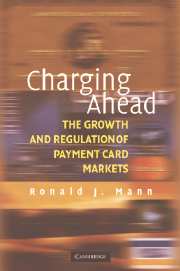Book contents
- Frontmatter
- Contents
- Figures and Tables
- Acknowledgments
- Introduction
- PART I THE BASICS OF PAYMENT CARDS
- PART II EASY MONEY
- PART III THE PUZZLE OF PAYMENT CARDS
- 6 Explaining the Pattern of Global Card Use
- 7 The Introduction of the Payment Card
- 8 Revolving Credit
- 9 Point-of-Sale Debit
- 10 Convergence and Exceptionalism in the Use of Cards
- PART IV REFORMING PAYMENT SYSTEMS
- PART V OPTIMIZING CONSUMER CREDIT MARKETS AND BANKRUPTCY POLICY
- Conclusion
- Appendix: Country-Level Data
- Notes
- Bibliography
- Index
7 - The Introduction of the Payment Card
Published online by Cambridge University Press: 06 July 2010
- Frontmatter
- Contents
- Figures and Tables
- Acknowledgments
- Introduction
- PART I THE BASICS OF PAYMENT CARDS
- PART II EASY MONEY
- PART III THE PUZZLE OF PAYMENT CARDS
- 6 Explaining the Pattern of Global Card Use
- 7 The Introduction of the Payment Card
- 8 Revolving Credit
- 9 Point-of-Sale Debit
- 10 Convergence and Exceptionalism in the Use of Cards
- PART IV REFORMING PAYMENT SYSTEMS
- PART V OPTIMIZING CONSUMER CREDIT MARKETS AND BANKRUPTCY POLICY
- Conclusion
- Appendix: Country-Level Data
- Notes
- Bibliography
- Index
Summary
Credit cards as we know them today were introduced in the United States in the 1950s. The first product was the Diners Club card. Functioning much like the product we now call a travel-and-entertainment card or charge card, the Diners Club card was marketed to high-salaried business travelers. It responded to a specific problem with the checking system as it functioned in the United States at the time.
Specifically, business travelers needed some way to pay remote merchants for food and lodging without having to carry large sums of cash. Merchants were reluctant to accept a nonlocal check, because it was difficult to make an informed assessment of the likelihood that the traveler's bank would honor the check. Creditworthiness problems were aggravated by the long clearance times prevalent for nonlocal checks before the Expedited Funds Availability Act. To quote the U.S. Supreme Court's assessment, until Congress's 1987 enactment of the Expedited Funds Availability Act, 12 U.S.C. §§4001–4010, “[T]he check-clearing process too often lagged, taking days or even weeks to complete.”
As a response to that problem, the payment card was a brilliant invention. For the first time, bills from diverse places such as hotels, restaurants, and airlines were consolidated, reimbursed by the issuer, and then billed to the customer to be repaid in full the next month. Among other things, this placed the billing function in the hands of an intermediary, so that alternative payment devices were unnecessary and the restaurant did not have to extend credit by invoicing a customer directly.
- Type
- Chapter
- Information
- Charging AheadThe Growth and Regulation of Payment Card Markets around the World, pp. 81 - 85Publisher: Cambridge University PressPrint publication year: 2006

